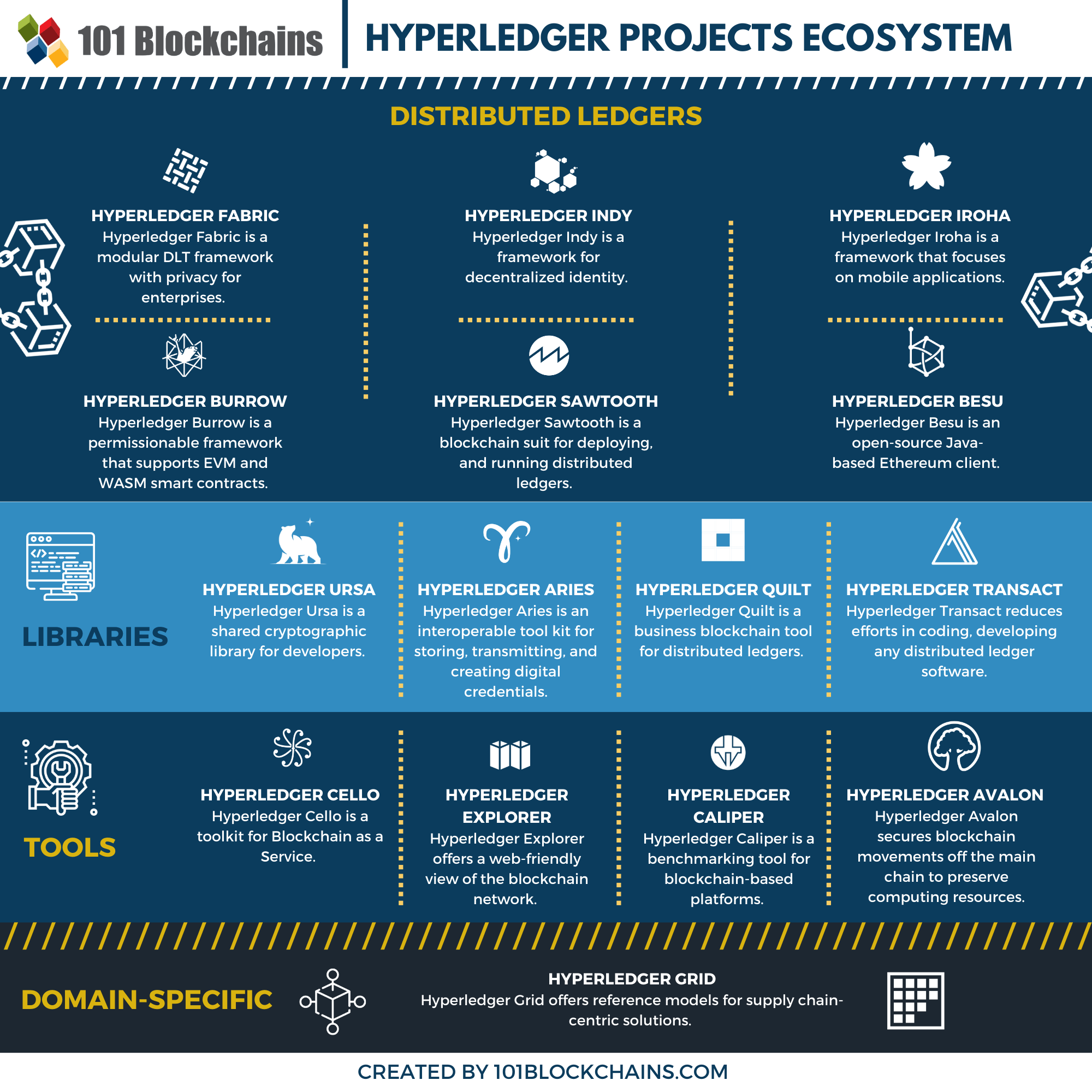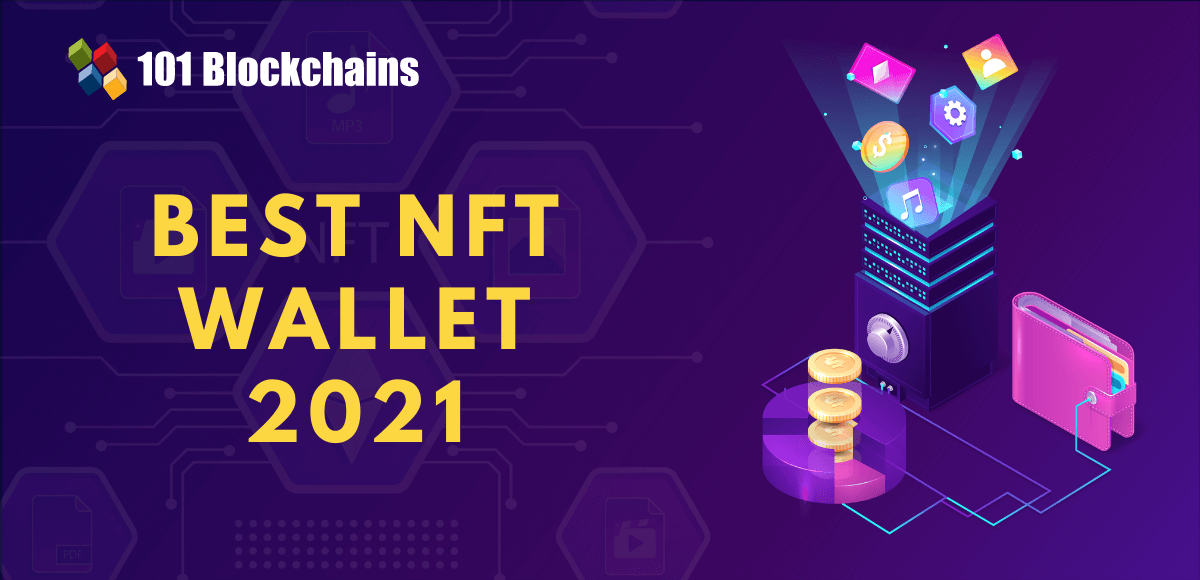Learn how blockchain truly works, master key definitions, and uncover what makes smart contracts so "smart." Dive into the fundamentals, gain valuable insights, and start your blockchain journey today!

- Reviews
Hasib Anwar
- on January 09, 2020
Hyperledger Project: 15 Projects You Should Know About
There are so many popular enterprise blockchain projects in the blockchain niche right now, and Hyperledger seems to be one of them. However, Hyperledger is not a single framework but an umbrella project where there are other Hyperledger projects under it.
In reality, Hyperledger can be a great choice if you are looking to implement a blockchain-based solution. That’s why today, I’ll be talking all about Hyperledger projects to help you decide which one is suited for your solution. However, at first, we’ll take a quick look into the basics of Hyperledger before diving in deeper.
So, let’s check them out!
Want to know everything about Hyperledger Fabric? Enroll Now: Getting Started with Hyperledger Fabric Course
What is Hyperledger?
Hyperledger is actually an open-source project backed up by Linux Foundation. More so, it comes with a wide selection of frameworks, libraries, tools, and many more. Basically, you may call it the greenhouse of blockchain.
Hyperledger project members help enterprises to come up with unique blockchain solutions along with assisting them in adapting to the solutions as well. Hyperledger started back in 2015 for the sake of advancing blockchain for enterprises. However, to do that, the company formed a consortium of many high-end enterprises.
Take a deep dive into common hyperledger terms with the Hyperledger Flashcards
Why is it Open Source?
You might be thinking why the Hyperledger project is open source. Basically, typical manufacturer licensed software comes with a lot of limitations. Well, first of all, it comes with vendor lock-downs, and more so, it won’t let you change any of the core codes.
However, in open source, you get more freedom of changing, downloading the code. Open source platforms grow exponentially as well, which makes sense for an enterprise environment.
Lastly, as the Hyperledger project really wants to help in advancing enterprise blockchain implementation, it’s best to keep it open for everyone to use.
Please include attribution to 101blockchains.com with this graphic. <a href='https://101blockchains.com/blockchain-infographics/'> <img src='https://101blockchains.com/wp-content/uploads/2020/01/Hyperledger-Projects.png' alt='Hyperledger Projects='0' /> </a>
What Are The Benefits of Hyperledger Project?
-
Keep Up With Developments
It’s quite challenging to keep up with the developments of open source platforms. That’s why many companies may want to give it up. But with Hyperledger project members, you’ll get a collaborative environment. So, in the end, you’ll get full support in making the solution from the Hyperledger project members.
-
Increased Productivity
According to Hyperledger project wiki, while working with the project members, you’ll notice that they don’t let every people work as they please. More so, they tend to follow specialization when diving up the labor. In this one, Hyperledger project members only take what they are best at and work on that. As a result, you’ll get an efficient, productive line while working on your project.
-
Collaborative Approach
This is one of the best benefits of Hyperledger projects. In reality, all the Hyperledger project members work in a collaborative environment. Usually, when a new technology emerges, companies tend to duplicate each other’s developments. But not in Hyperledger. Here, everyone will work together to come up with a unique solution and streamline the overall development.
-
High-Quality Code
Hyperledger projects come with high-quality code in all of their platforms. Basically, according to Hyperledger project wiki, the project members carefully observe every single codebase before they launch them in the market. Also, the technical community of this company is highly professionals as they review every single line and tests them out vigorously before launching it.
-
Handling of Intellectual Property
Hyperledger ensures that intellectual property within their system is being taken care of. By default, all the contents on their system come with licensed properties. As a result, any kind of intellectual property is safe within the system.
Want to learn the basic and advanced concepts of Hyperledger development? Enroll Now – Hyperledger Fabric Development Course – Intermediate Level
Hyperledger Projects: 15 Projects to Check Out
Hyperledger currently has 15 projects under its wings. All of these projects are specifically designed to meet the demands of enterprises. Anyhow, let’s check them one by one and see what each of them offers.
Distributed Ledgers
Hyperledger Burrow
Status: Incubation
Hyperledger Burrow is a framework that’s mainly suited for developers. In reality, it’s mainly optimized for public permissioned blockchain; however, you can also use it as private or consortium blockchains.
Moreover, it supports EVM and smart contracts.
Significant Components of Hyperledger Burrow
-
Engine for Consensus
According to Hyperledger project wiki, Burrow comes with Byzantine Fault-Tolerant Tendermint protocol. In reality, it’s a new type of protocol that offers a greater transaction rate. However, you can’t fork this framework.
-
Application Binary Interface (ABI)
It comes with many awesome tools that will let you deploy, compile, and even link to other solidity based smart contracts in the network.
-
Ethereum Virtual Machine (Permissioned)
According to Hyperledger project wiki, it uses a permissioned EVM to observe whether the network has the right level of permission. So, it kind of differentiates between the different layers of permission.
-
Smart Contract Applications
In Hyperledger Burrow, you can call a smart contract while in the transaction process. Basically, the virtual machine will execute the smart contracts called within the transaction.
-
Application Blockchain Interface (ABCI)
ABCI is responsible for connecting a consensus engine with the smart contract application layer. Thus, it ensures that the consensus engine is agnostic in terms of smart contract applications.
Curious to learn about blockchain implementation and strategy for managing your blockchain projects? Enroll Now in Blockchain Technology – Implementation And Strategy Course!
Hyperledger Fabric
Status: Active
Hyperledger Fabric project is one of the most popular modular projects under Hyperledger. In reality, the platform is fully optimizable. Thus, you can use it for any kind of use case. Furthermore, with the Hyperledger Fabric project, you’ll get confidentiality, flexibility, resiliency, scalability, and many more.
Anyhow, the Hyperledger Fabric project runs on the general-purpose programming language. As a result, there isn’t any native token for this.
Features of Hyperledger Fabric project
-
The Modularity
It comes with a modular design. So, you can just plug in any feature and just start using it. There are some modules already available to use, such as ordering services, membership providers, gossip services, smart contracts, etc.
-
Smart Contracts
In the Hyperledger Fabric project, smart contracts are called chaincode. In reality, it’s a bit different than typical smart contracts as it can get all the functions it needs form the blockchain network. More so, it follows three steps – execution, ordering, and validation.
Curious to understand the complete smart contract development lifecycle?Enroll in Smart Contracts Development Course Now!
-
Pluggable Hyperledger Fabric Consensus Protocols
This is by far the best features of Fabric. All the consensus mechanism within the system is completely pluggable. So, you can use a wide number of consensus whenever you want. There’s no restriction in that.
Hyperledger Indy
Status: Active
Hyperledger Indy project is another popular Hyperledger project. Basically, it’s a framework explicitly made for decentralized identities. More so, it comes with loads of components, toolsets, and libraries for you to use.
The best part is that it powers users as users will get the sole ownership of their very own identities.
Main Features of Hyperledger Indy Project
-
Self-sovereignty
In the Hyperledger Indy project, you can store all your identity-based documentation on the network. Basically, all the contents will have cryptographic encryptions, proof of existence, private key and public keys, and many more. Only you can alter or make changes to those documents.
-
Privacy
Well, the Hyperledger Indy project comes with a secured layer of confidentiality for protecting all your valuable documents. Everything will remain only in the ledger, and no one can even track down your identity from another link or ledger.
-
Verifiable Claims
In many cases, you may have to show some form of identity documentation, such as a birth certificate or driving license to prove it. But in many cases, people can misuse these documents as well. Thus, you can only choose to disclose selective portions of your document to prove your identity.
Hyperledger Iroha
Status: Active
Hyperledger Iroha is another solid blockchain framework. With this framework, it’s super easy to integrate into any existing enterprise networks. The project came after Fabric and Sawtooth. Anyhow, you can use this platform for healthcare, education, cross-border payments, financial services, DIDs, and many more.
Key Features of Hyperledger Iroha
- Deploying the platform is super easy and straightforward. There are no complicated options or any confusing attributes. Also, you can do in-house maintenance with a little bit of training.
- Also, you’ll get access to tons of libraries, and these are basically suited for developers.
- The access control in this platform is role-based.
- More so, the design structure of Hyperledger Iroha is modular like other Hyperledger projects.
- It also comes with command-queries.
- Furthermore, you’ll also get asset and identity management.
Anyhow, they also have a control model where they carefully work on these following models –
- Performance: Here, Hyperledger Iroha works on their time and resource utilization giving you the fastest output.
- Reliability: In reality, they also offer fault tolerance and recovery in case of any unfortunate situation.
- Usability: Here, Hyperledger Iroha can deter user errors and learns from as the platform develops, improving itself to be better.
Hyperledger Sawtooth
Status: Active
Hyperledger Sawtooth is actually a blockchain suit for deploying, running, and building distributed ledgers. Many enterprises have a hard time working with the complex nature of blockchain technology. That’s why Sawtooth offers the perfect solution as it makes implementing blockchain solutions an easy task.
Features of Hyperledger Sawtooth
-
Dynamic Consensus
Here, anyone can change a consensus in a live blockchain network. More so, you can even do it in the transaction process. But you have to choose available consensus plugins for that.
-
Proof of Elapsed Time (PoET)
It’s a new type of consensus algorithm. Mainly it’s on by default, but you can change it if you need it. In reality, the work process is quite unique, and it consumes very less energy.
-
Transaction Families
You can write smart contracts in any language, there will be no restriction in that.
-
Ethereum Contracts Compatibility
Another best feature of Hyperledger Sawtooth is that it’s 100% compatible with Ethereum smart contracts. So, if you want to use that, you can do it by plugging EVM.
-
Parallel Transaction Execution
It also comes with parallel transaction execution saving you a lot of time.
-
Private Transactions
You can create individual chains where you can keep all your confidential transactions easily.
Hyperledger Besu
Status: Incubation
Hyperledger Besu is actually an open-source Ethereum client. In reality, the project is written in Java and uses the Apache 2.0 license. You can run it on any private permissioned platform or on Ethereum public network as well.
Features of Besu
-
Ethereum Virtual Machine (EVM)
The use of EVM in the system allows it to execute Ethereum based smart contracts and many other features.
-
Consensus Algorithms
Hyperledger Besu comes with a wide range of consensus algorithms for validating blocks. These are –
- Proof of Authority is suitable when peers within the system know each other and trust each other. It’s a great protocol that uses very low power.
- In IBFT 2.0, validators approve blocks and transactions. It’s a fault-tolerant consensus protocol.
- Clique is a unique consensus algorithm as it’s twice the fault-tolerant than IBF 2.0.
- Proof of Work is not the primary consensus but only used in the Ethereum mainnet.
-
Discovery
You will get a UDP-based protocol to find any peer in the network.
-
User-facing APIs
With Besu, you’ll get EEA JSON-RPC APIs instead of HTTP, mainnet Ethereum, GraphQL API, and WebSocket protocols.
-
Monitoring
The framework monitors network and node performances. It also ensures privacy and permissioned access.
Hyperledger Caliper
Status: Incubation
Hyperledger Caliper is a unique kind of project. In reality, it’s a benchmarking tool for other blockchain-based platforms. Actually, while developing solutions, enterprises don’t really have an ideal model to compare it with. As a result, most of the companies don’t know whether the solution is enough or not.
That’s why in Caliper, you can pre-define use cases, and Caliper can tell you whether it’s ready for that or not.
More so, the best part is that it doesn’t come with any pre-defined standard. Why? Well, it’s because all the blockchain implementations are different. So, judging them under the same criteria won’t give out the right result.
That’s why companies can outline their required output and, based on that, test out their solution. Basically, it’s a wonderful tool for developers and enterprises.
Hyperledger Cello
Status: Incubation
Hyperledger cello is another awesome toolkit for Blockchain as a service. With this, you can easily create, terminate, or even manage all your blockchain services. Basically, the primary target is to create an innovative approach to the blockchain ecosystem. Also, enterprises seem to be more eager for BAAS as it saves them time and money.
Thus, this tool is more suited for vendors that want to offer BAAS for enterprises. It will let them create the platforms quite efficiently. From the dashboard of this tool, you can check the status of your network, see chaincode performances, get analytical data, and many more.
Currently, it only supports Hyperledger Fabric. But it’s soon to include more frameworks as well. Anyhow, the architecture is also modular, so you can enjoy pluggable options as well.
Want to learn all the fundamentals of Blockchain as a Service? Enroll Now – Getting Started with AWS Blockchain as a Service (BaaS)
Hyperledger Explorer
Status: Incubation
Hyperledger Explorer is another wonderful project under Hyperledger. Mainly, it offers a web-friendly view of the blockchain network. In reality, with this, you can check nodes, transactions, statistics, blocks, smart contracts, and many more.
But why use it? Well, it’s more convenient that you can check up on all of these from a single place. Also, developers need to check how the system is doing before rolling it out in the market. Thus, Explorer is a perfect option for that.
It will also let you make changes in your code if you find any issues. Also, if you have an in-house security team for the network, then using this tool to maintain that is quite straightforward.
Anyhow, it’s actually an effort to make blockchain solution much easier and accessible to all.
Hyperledger Avalon
Status: Incubation
Previously, Hyperledger Avalon was Trusted Compute Framework. But they named it to Avalon during the collaboration phases. It’s a product of collaboration between EEA, Hyperledger, and cloud service providers. Basically, this tool helps to secure blockchain movements off the main chain to preserve computing resources.
More so, it ensures all developers to get all the benefits from computational trust and limit all the drawbacks. Anyhow, it will maintain a registry for trusted workers. It will also offer a process for clients to submit orders to workers. In reality, Avalon will also preserve a log for work done in the ledger.
Hyperledger Quilt
Status: Incubation
Mainly, it’s a business blockchain tool for distributed ledgers. But with Quilt, you are getting interoperability between the ledgers. In reality, interoperability is just a speculation, and no other blockchain platform could pull it off. But in Quilt, they are trying to do that.
So, with this tool, you can communicate with other ledger systems without any issues. The best part is that you can send money from another country without having the same platform. Basically, here, the transaction is packetized and routes it to the destination.
Anyhow, you’ll be getting frameworks for implementing this structure and also a set of interoperability rules that you need to follow.
Quilt isn’t still active yet, it’s currently in incubation phase and needs more time to complete.
Hyperledger Ursa
Status: Incubation
Hyperledger Ursa happens to join the project list recently. It’s actually a shared cryptographic library. In this one, it tracks all the cryptographic work within a framework. But why use it? Well, you definitely don’t want to duplicate work in the ledger, do you? With Ursa, you can easily avoid that.
As it will track all the previous entries, it will prevent any duplication later in the future. The best part is that it’s totally modular and it supports all other Hyperledger based projects as well.
In reality, with Ursa, you are getting a high level of security. Also, it’s an open ecosystem, so experts will comment on the cryptography, helping newcomers to develop their cryptography models better.
More so, it also offers interoperability. Anyhow, it’s also in the incubation phase, and we don’t know exactly when it will be available.
Hyperledger Aries
Status: Incubation
Hyperledger Aries is actually an infrastructure for peer-to-peer blockchain-based transactions. However, it’s not a framework or application. Anyhow, the primary target is to offer code for secrets managements, peer-to-peer interaction, secure messaging, and verifiable information exchange for multiple decentralized environments.
In reality, it will expand the applicability in Indy in the future as it will foster interoperability support in all the existing standards. Thus, making it an effective and single business solution.
The blockchain interfaces layer or resolver of the library signs and creates blockchain transactions. Additionally, a cryptographic wallet will secure all secret documents and assets of the user. It also offers an encrypted messaging system so that peers can communicate without worrying about any security.
As it comes with zero-knowledge proof, you can verify a transaction without revealing the contents of that transaction. Furthermore, there is a mechanism that will help in creating APIs and protocols for certain use cases
Hyperledger Transact
Status: Incubation
It’s a library for developers. With Hyperledger Transact coding, developing any distributed ledger software would be an easy task. In reality, the library can handle everything related to smart contracts such as transaction dispatch, scheduling, state management, and many more.
So, if you are using any Hyperledger frameworks or have custom distributed ledgers, then you can add Transact’s state management and advanced transaction execution for simplifying the process of executing codes.
Anyhow, with this library, you can execute transactions in many ways, you can get serial and parallel execution, get the support of Merkle-Radix Tree, etc. More so, you can also generate events from smart contracts and use languages such as JavaScript, Python, Rust, Swift, and many more.
It also supports EVM.
Domain-Specific
Hyperledger Grid
Status: Incubation
Grid is here to solve all your issues in the supply chain. It’s actually a WebAssembly based project. Therefore, you’ll get access to lots of libraries, data models, SDKs, and many more. Also, these are all suited for developing client interfaces and smart contracts.
It doesn’t directly quote any restriction in using other platforms; however, it does offer security if you use it on any other niche rather than the supply chain. And also, the libraries can run on other platforms as well.
It may seem like an application, but in reality, it’s not. Thus, it’s more of a suite with access to lots of frameworks and tools.
Hyperledger Grid doesn’t want to limit innovation when it comes to cross-industry supply chain management. So, if you are in that niche, you may give it a try.
Start learning Blockchain with World’s first Blockchain Career Paths with quality resources tailored by industry experts Now!
In The End
Hyperledger Projects are here to make blockchain development easier and more straightforward. Every single project of Hyperledger is a result of collaboration. Here, multiple companies developed the solution and made it open-source for everyone to try out.
Even though currently, they only have 4 projects that are active, still, most of the other projects look promising enough. If you are looking for enterprise blockchains, then Hyperledger projects can surely help you out with that. You can also join their ecosystem to help in contributing to other cool solutions and escalate the blockchain transformation.
*Disclaimer: The article should not be taken as, and is not intended to provide any investment advice. Claims made in this article do not constitute investment advice and should not be taken as such. 101 Blockchains shall not be responsible for any loss sustained by any person who relies on this article. Do your own research!







